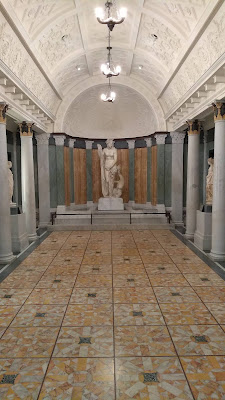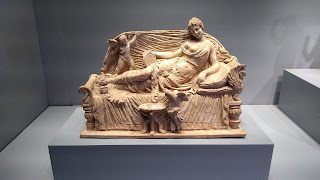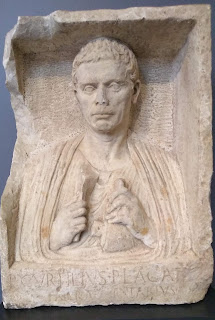 The Getty Villa is based on the shape of an original that was buried by the eruption of Vesuvius in 79AD. Almost 1900 years later it was clear that Getty’s version could never be an accurate replica, because nobody knew what the Villa of the Papyri had looked like above ground. Most of what remained was at floor level, and at the time much of that had only been explored via tunnels hacked through the buried remains in the eighteenth century. Where the evidence failed, Getty’s site drew inspiration from other villas of the time, along with necessary adaptations (such as a wide, accessible staircase) for modern use.
The Getty Villa is based on the shape of an original that was buried by the eruption of Vesuvius in 79AD. Almost 1900 years later it was clear that Getty’s version could never be an accurate replica, because nobody knew what the Villa of the Papyri had looked like above ground. Most of what remained was at floor level, and at the time much of that had only been explored via tunnels hacked through the buried remains in the eighteenth century. Where the evidence failed, Getty’s site drew inspiration from other villas of the time, along with necessary adaptations (such as a wide, accessible staircase) for modern use.
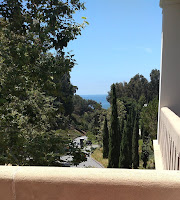 His creation is cleverly placed so external roads, service buildings and the Museum car park can’t be seen from the gardens. It lies between Malibu and Venice beach – a location that makes surprisingly good sense despite being on a continent of which the Caesars knew nothing. The Romans would have felt more at home in this climate than in Britain, where imperial attempts to live in a traditional Roman courtyard house (some were optimistically built for fort commanders) must have left the occupants chilly, damp and homesick.
His creation is cleverly placed so external roads, service buildings and the Museum car park can’t be seen from the gardens. It lies between Malibu and Venice beach – a location that makes surprisingly good sense despite being on a continent of which the Caesars knew nothing. The Romans would have felt more at home in this climate than in Britain, where imperial attempts to live in a traditional Roman courtyard house (some were optimistically built for fort commanders) must have left the occupants chilly, damp and homesick. 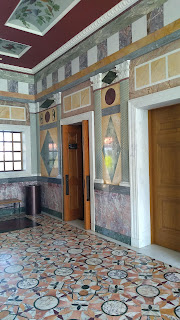
For a pair of modern and seriously overheated Britons, though, one of the unexpected delights of a stroll through the Getty villa was to linger on a cool marble bench, admire the splash of the fountains and feel the breeze wafting through the open doorways and colonnades. We had escaped the Los Angeles traffic jams just as powerful Roman families might have fled from the summer heat and bustle of Rome.
Something else that struck home was the number of people needed not only to create this sort of luxury but to maintain it. Especially in an age before electricity and telephones, there would have been not only personal slaves but squads of cooks and cleaners and gardeners and clerks and people scurrying around refilling oil lamps and carrying messages. All of these necessary workers must have been housed and fed and expected to be “seen and not heard”. (Although given the numbers of columns and niches, ornamental trees and full-size statues, perhaps they were supposed to slip in and out without being much seen, either.)
This vast area is the same length as the original. I suspect the water here is much cleaner, but it is nowhere near as deep. The Roman owner (probably Lucius Calpurnius Piso) may have had to contend with the insults of Cicero, who described him as “profligate, filthy and intemperate,” amongst other things, but at least he was not restricted in his ambition by having a car park directly underneath his pool.
A few favourites from the collection:
This head of Tiberius had his nose and chin reconstructed in 2013. Is such restoration helpful, or is it unwarranted interference? It’s a question raised elsewhere in the collection. For those of us who had seen too many statues with no noses over the years, it was a welcome change.
As Getty suspected, this is not an ancient item. It was actually made sometime after 1875 but, with the passage of time, it’s become interesting in its own right.
Getty’s inspiration – the Villa of the Papyri - is named after the vast number of charred scrolls found in it. Decades of work have destroyed some and still others remain undecipherable. What’s legible is mostly in Greek, leading to hopes that there might be a Latin library as yet undiscovered.
A peacock - noisy as a pet, tasty on the dinner table.
The late Publius Curtilius Agatho, Silversmith. Such a lifelike portrayal that I feel we would all recognise him if we met him in the street.
Meanwhile, the anonymity of the two below is deliberate. Nobody has destroyed the faces - they're just waiting to be carved to resemble whoever might be buried in here. 
Hard not to see this as “Aphrodite plays air guitar.” 
Our only eye-witness description of the eruption of Vesuvius comes from Pliny the Younger, who describes the cloud as looking like a pine tree, rising into the sky on a long “trunk” with branches spreading out at the top. This pine spreading over the villa is a reminder of the tragedy that struck the people living around the volcano.

"The true collector," Getty believed, “...is willing and even eager to have others share his pleasure.” Yet although he was heavily involved in the design, Getty never visited the villa and could not have witnessed the pleasure that it gave to others. He died two and a half years after the opening, leaving the Museum a bequest of four million shares of Getty Oil stock and making it the richest art institution in the world.
Find out more here - https://www.getty.edu/visit/villa/
Guide to the Getty Villa – Getty publications – ISBN 9781606065471

